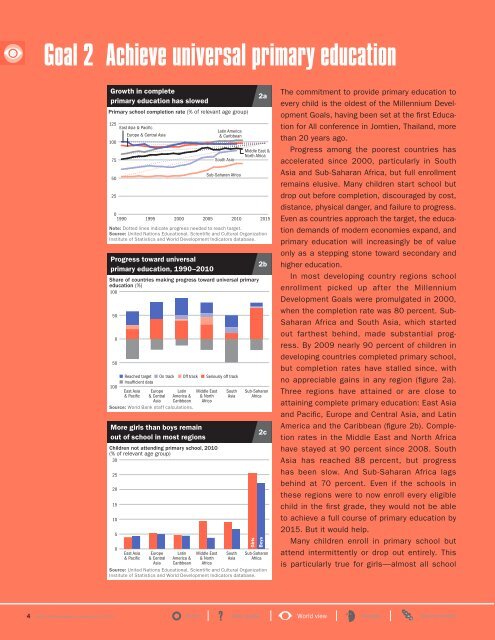World Development Indicators 2013 - Open Knowledge Repository ...
World Development Indicators 2013 - Open Knowledge Repository ...
World Development Indicators 2013 - Open Knowledge Repository ...
You also want an ePaper? Increase the reach of your titles
YUMPU automatically turns print PDFs into web optimized ePapers that Google loves.
Goal 2 Achieve universal primary educationGrowth in completeprimary education has slowedPrimary school completion rate (% of relevant age group)125East Asia & PacificEurope & Central Asia10075502501990Progress toward universal2bprimary education, 1990–2010Share of countries making progress toward universal primaryeducation (%)10050050100More girls than boys remainout of school in most regionsChildren not attending primary school, 2010(% of relevant age group)302520151050Reached target On track Off track Seriously off trackInsufficient dataEast Asia& PacificEast Asia& Pacific1995Europe& CentralAsiaEurope& CentralAsia2000LatinAmerica &CaribbeanSource: <strong>World</strong> Bank staff calculations.LatinAmerica &Caribbean2005Middle East& NorthAfricaMiddle East& NorthAfricaLatin America& CaribbeanSouth AsiaSub-Saharan Africa2010SouthAsiaSouthAsia2aMiddle East &North AfricaSub-SaharanAfrica2cGirlsBoysSub-SaharanAfricaSource: United Nations Educational, Scientific and Cultural OrganizationInstitute of Statistics and <strong>World</strong> <strong>Development</strong> <strong>Indicators</strong> database.2015Note: Dotted lines indicate progress needed to reach target.Source: United Nations Educational, Scientific and Cultural OrganizationInstitute of Statistics and <strong>World</strong> <strong>Development</strong> <strong>Indicators</strong> database.The commitment to provide primary education toevery child is the oldest of the Millennium <strong>Development</strong>Goals, having been set at the first Educationfor All conference in Jomtien, Thailand, morethan 20 years ago.Progress among the poorest countries hasaccelerated since 2000, particularly in SouthAsia and Sub- Saharan Africa, but full enrollmentremains elusive. Many children start school butdrop out before completion, discouraged by cost,distance, physical danger, and failure to progress.Even as countries approach the target, the educationdemands of modern economies expand, andprimary education will increasingly be of valueonly as a stepping stone toward secondary andhigher education.In most developing country regions schoolenrollment picked up after the Millennium<strong>Development</strong> Goals were promulgated in 2000,when the completion rate was 80 percent. Sub-Saharan Africa and South Asia, which startedout farthest behind, made substantial progress.By 2009 nearly 90 percent of children indeveloping countries completed primary school,but completion rates have stalled since, withno appreciable gains in any region (figure 2a).Three regions have attained or are close toattaining complete primary education: East Asiaand Pacific, Europe and Central Asia, and LatinAmerica and the Caribbean (figure 2b). Completionrates in the Middle East and North Africahave stayed at 90 percent since 2008. SouthAsia has reached 88 percent, but progresshas been slow. And Sub- Saharan Africa lagsbehind at 70 percent. Even if the schools inthese regions were to now enroll every eligiblechild in the first grade, they would not be ableto achieve a full course of primary education by2015. But it would help.Many children enroll in primary school butattend intermittently or drop out entirely. Thisis particularly true for girls—almost all school4 <strong>World</strong> <strong>Development</strong> <strong>Indicators</strong> <strong>2013</strong> Front ? User guide <strong>World</strong> view People Environment
















